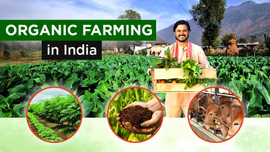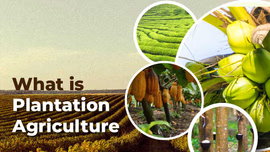Profitable Avocado Farming in India: Status, Techniques & Future Prospects

Avocado is a high-value crop that is also rich in nutritional value. This is why it is highly demanded by health-conscious consumers. The increasing global demand for avocados has made avocado cultivation a profitable venture for farmers. Even though there is a lack of large-scale commercial farming of avocados in India, its future is promising because of growing health awareness and consumer demand. Get step-by-step guidance related to climate, field preparation, irrigation, pest management, and marketing for maximum profit.
Table of Contents
- Introduction to the Avocado Fruit & its Nutritional Profile
- Which are the Top Avocado Producing Countries?
- Status of Avocado Production in India
- What are the Key Cultivation Steps involved in Avocado Farming?
- Future of Avocado Production in India
Introduction to the Avocado Fruit & its Nutritional Profile
The origins of avocado (Persia americana) can be traced back to tropical America, with roots in Central America and Mexico. It is also referred to as butter fruit owing to its creamy, buttery texture and subtle taste. Avocado cultivation has gained traction due to its rising global demand for this nutrient-rich fruit. The avocado pulp has rich amounts of good fats and proteins along with potassium, iron, copper, and folate. This is why this avocado is classified as a superfood globally.
Fresh avocado is widely used in salads and as a sandwich filling. It is also a key ingredient of guacamole, milkshakes, and ice cream. As per an analysis, avocados have three times more protein than apples. As per the Food and Agriculture Organization (FAO), the following is the nutritional profile of an avocado per 100 g of edible portion:
|
General Composition |
Energy value (cal.) |
245 |
Minerals (mg) |
Sodium |
368 |
|
Fat (g) |
26.4 |
Phosphorus |
38 |
||
|
Carbohydrates (g) |
5.1 |
Magnesium |
35 |
||
|
Crude fibre (g) |
1.8 |
Sulphur |
28 |
||
|
Protein (g) |
1.7 |
Chlorine |
11 |
||
|
Vitamins (mg) |
Ascorbic acid |
16 |
Calcium |
10 |
|
|
Niacin |
1.10 |
Manganese |
4.21 |
||
|
Vitamin A as carotene |
0.17 |
Iron |
0.60 |
||
|
Riboflavin |
0.13 |
Copper |
0.45 |
||
|
Thiamine |
0.06 |
|
|
Which are the Top Avocado Producing Countries?
Below are the top countries that produce the most avocados:
|
Country |
Production 2022 (Tonnes) |
|
Mexico |
2,529,581 |
|
Colombia |
1,090,664 |
|
Peru |
866,457 |
|
Dominican Republic |
737,201 |
|
Kenya |
458,439 |
|
Indonesia |
389,000 |
|
Brazil |
338,238 |
|
Vietnam |
210,595 |
|
Israel |
189,667 |
|
Haiti |
173,507 |
Status of Avocado Production in India
Avocado is not a major commercial fruit crop in India. However, avocado farming is catching on due to increasing demand and high profit potential. In the early 20th century, this fruit was introduced from Sri Lanka. In India, the major avocado-producing states are found in the southern region, including Karnataka, Maharashtra, Kerala, and Tamil Nadu. This is mainly because avocados cannot endure frosts and the hot, dry winds of North India. The avocado cultivars grown in major avocado growing areas include Arka Supreme, Green Type, TKD-1, Waldin, Purple, Furete, Nabal, Gott-Froid, Puyevla, and Linda.
What are the Key Cultivation Steps involved in Avocado Farming?
Soil & Climate
Avocado grows well in tropical to sub-tropical humid climates. However, varying horticultural races and varieties require specific conditions. In avocado-growing areas of Sikkim, the Gautemalan and Mexican races are grown in a temperature range of 12-30°C with an average annual rainfall of 2000 mm. This fruit does not prefer saline conditions, while the ideal pH range is 5-7. It can grow in different soil conditions, but it demands well-drained soil without occurrences of waterlogging.
Propagation
Seeds are used for the propagation of the avocado. Also, the seed viability of avocado is short, which is around 2-3 weeks. Store the seeds in dry sand or peat at 5°C to improve their viability. Also, the seed coat can be removed before sowing to hasten the germination rate. Seeds are obtained from mature fruits to be sown in polyethylene bags or a nursery. They are ready to be transplanted when they become 8-12 months old. It takes time for a seeding tree to begin fruiting. Also, there is high variability in the overall yield and fruit quality. Genetically uniform plants are challenging to obtain due to high variability in seedlings resulting from cross-pollination. To avoid these issues, superior clones of avocado can be used for vegetative propagation via grafting or budding.
Field Preparation & Planting
It is highly important to select a suitable avocado variety to be planted in a new field. Avocado varieties are classified into Type A and Type B groups depending on their flowering schedules. In Type A, the first opening of flowers occurs in the morning, while the second opening takes place during the afternoon of the next day. The first opening occurs in Type B during the afternoon, and the second opening happens the next morning. Select varieties belonging to both A and B groups and ensure their flowering overlaps. A and B group varieties can be used in the proportion of 1:1 or 2:1.
Based on the growth habit and vigour of the variety, avocado can be planted at a distance of 6-12 m. A wider spacing is required for the Fuerte variety. If there is excess water, plant them on mounds to overcome waterlogging. On the hill slopes of Sikkim, a 10 x 10 m planting distance is preferred. Avocado is planted with coffee in South India at a planting distance of 6-12 m. During April-May, 1 cubic meter of pits is dug to be filled with topsoil and FYM in the ratio of 1:1 before planting. The ideal time for planting is June-July or September.
Fertilizer Application
Heavy manuring is required in avocado farming, with nitrogen application being the most important. Young avocado trees demand N, P2O5, and K2O in a 1:1:1 ratio, while it is 2:1:2 for older trees. Apply iron chelate at a 35 g/tree rate to correct iron deficiency symptoms caused by a pH above 7. The following is the recommended fertilizer schedule for avocado:
|
|
Plant Age (Year) |
||||||
|
1 |
2 |
3 |
4 |
5 |
6 |
7 & Above |
|
|
Nitrogen (g/plant) |
100 |
200 |
300 |
400 |
500 |
600 |
800 |
|
Phosphorus (g/plant) |
30 |
60 |
90 |
120 |
150 |
180 |
210 |
|
Phosphorus (g/plant) |
60 |
120 |
180 |
240 |
300 |
360 |
400 |
|
Farmyard manure (kg/plant) |
- |
10 |
20 |
30 |
40 |
50 |
60 |
Training & Pruning
Light pruning is required in the initial stages of the plants to help develop an open centre canopy. Topping is done in upright varieties like Pollock to reduce the tree size. On the other hand, thinning and shortening are done for spreading varieties like Fuerte. For easy cultural practices, pruning of dropping and ground-touching branches is required. Due to heavy pruning, excessive vegetative growth can occur, resulting in lower yields.
Irrigation
Avocado farming is practiced in regions experiencing high rainfall, which is fairly distributed all year long. Irrigation is generally not required in rain-fed conditions. During dry months, irrigation at a 3–4 week interval is recommended. Fruit size and oil percentage can be improved with the help of sprinkler irrigation. Mulching with dry leaves/dry grass is recommended to prevent moisture stress during the winter season. There should be no flooding, as it causes root rot.
Intercultural Operations
As avocado has surface roots, there is no requirement for deep cultivation. In young orchards, it is recommended to intercrop with legumes or shallow-rooted crops. Sod culture can be practiced with a monoculture plantation of avocado. South Indian regions with high rainfall face the major issue of weeds. Weed management is possible with the use of glyphosate or gramoxone. In the case of intercropping coffee and avocado trees, weed control can be achieved with scruffling done for coffee. During scruffling, ensure that avocado roots are not disturbed.
Harvesting & Yield
In the case of avocado grown from seeds, plants bear fruit after 5-6 years after planting. On the contrary, grafted plants start bearing in 3 to 4 years. Purple varieties change their colour to maroon when mature, while the green varieties turn greenish yellow. On maturing, the glossiness of fruits diminishes, and a smoother skin surface is developed.
When the seed coat changes its colour from yellowish white to dark brown, the fruits are ready to be harvested. After 6-10 days of harvesting, the ripening of mature fruits happens. When the fruits are on the trees, they remain hard. Only after harvest, they start to soften. During the rains, harvesting is not recommended. Also, fruits should not be exposed to direct sunlight. The yield is noted to be around 100-500 fruits per tree. The harvesting time for different regions is as follows:
- Sikkim: July to October
- Coorg area: June to October
- Tamil Nadu: July to August
Pest & Disease Management
The main diseases affecting avocado are scab, stem rot, leaf spot, and root rot. The insect pests of avocado are scales, mealy bugs, and mites. In addition, the storage diseases impacting avocado are anthracnose, stem-end rot, and fusarium rot. Proper spraying of chemicals and care is required to prevent pest and disease infestation.
Post-Harvesting & Marketing
To prevent infection, clean avocados using a soft cloth dipped in 150 ppm hypochlorous acid. Spreading of diseases can be prevented through hot water treatment for 3-5 minutes at 50°C and fungicide treatment. Store avocados at 12-13°C and relative humidity between 90-95 %. For the domestic market, grading should be performed on the basis of size as follows:
- Small: 250 gm
- Medium: 500 gm
- Large: 1000 gm
For export purposes, a weight of 125-1220 gm is recommended. Food-grade waxing helps in improving the external appearance and reducing moisture loss. Also, pack avocados in strong, well-ventilated containers. A size of 250-300 gm is preferred in India. The most popular varieties of avocados are Green, Fuerte, and Hass. The processed products of avocados include avocado chutney, avocado bread spread, and Spray-dried avocado powder.
Future of Avocado Production in India
Avocado farming is mostly done in Wayanad, Kallar, Lower Pulney hills, Kodaikanal, Shivamogga, Chikmagalur, and Coorg. Also, the highest rate of consumption is found in Kerala, parts of Tamil Nadu, Mumbai, Goa, and Bangalore. The agro-climatic conditions of several other Indian regions are favourable for avocado production.
There is a lack of an organized marketing system for avocados in India due to scattered production areas and low production. Several improved varieties of avocados are available that offer higher yields. Also, the standardization of vegetative propagation techniques has boosted avocado production. However, there is a need to establish high-quality nursery plants of selected varieties to ensure systematic planting and make avocado a mainstream commercial crop for Indian farmers. Also, there is a need for research support to help grow export-quality avocados on a large scale. It can be achieved through a governmental plan for strengthening the R&D of avocado in India.
Avocado has caught the attention of health-conscious consumers due to its high nutritional value. There is a good scope for avocado farming in India with better planting materials, varieties, and production technologies.
Frequently Asked Questions On Avocado Cultivation in India
1. Which country produces the most avocados?
Mexico is the largest producer of avocados globally.
2. Can avocado grow in India?
Yes, avocado can grow in India, mainly in the southern states, due to their tropical or subtropical climate.
3. Who is the largest exporter of avocados?
Mexico is the largest exporter of avocados.
4. What climate is best for avocados?
Avocado prefers tropical and subtropical climates and grows well in warm, humid weather.
5. Is avocado farming profitable?
Yes, avocado farming is profitable as it is an exotic fruit with high demand worldwide.


Related Blogs












